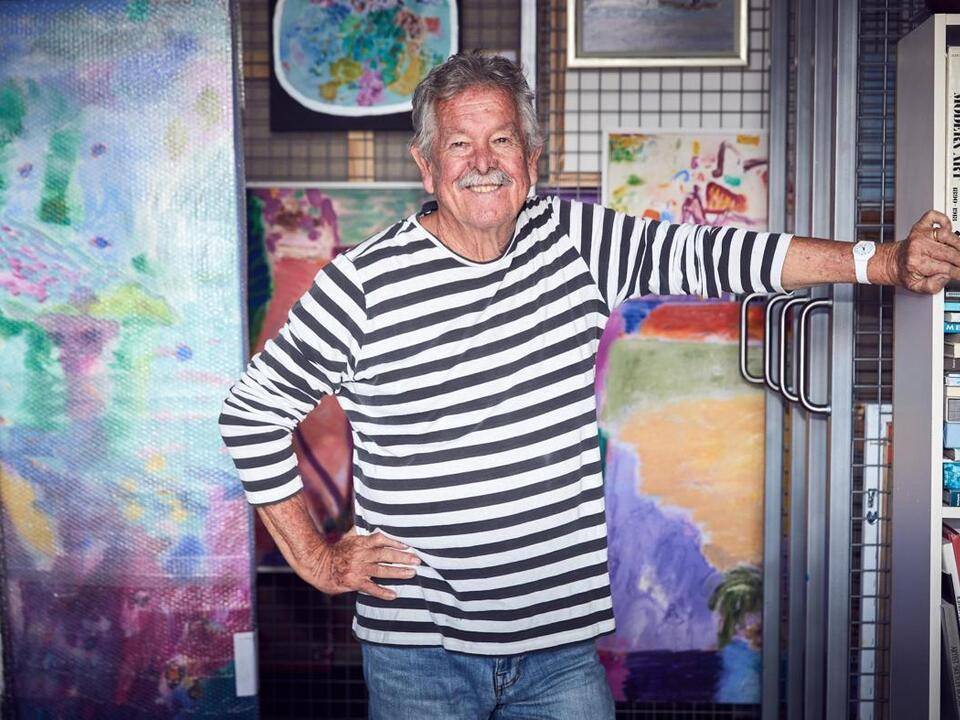Physical Address
304 North Cardinal St.
Dorchester Center, MA 02124
Physical Address
304 North Cardinal St.
Dorchester Center, MA 02124

No one paints Sydney Harbour like Ken Done. His joyous, brightly colored depictions of the Opera House and Harbour Bridge have decorated doona covers and duffel bags since the 1980s and remain loved by a new generation of Australiana appreciators.
Now aged 84, Done is still painting. He has a home studio on Rosherville Beach in Sydney, where he dutifully arrives for work most mornings and blasts music to get into the zone. Here, the legendary artist shares insights into the tools that aid his creative process and the story of an artwork he deeply misses.
Some paintbrushes I’ve had for a long time always make me feel good. Like a chef has certain knives they use in the kitchen, an artist has objects that sit comfortably in their hand. They’re the instruments you play.
I’ve probably got 100 brushes. There’s a big, square one that’s quite unusual; it sits in its own little wooden box. I don’t use it all the time, but it makes a very interesting mark. And then that goes all the way down to tiny little brushes. I don’t change brushes that often – I’m not interested in silky-smooth, soft watercolor brushes. I like something that’s a bit stronger, a bit gutsier, a bit tougher.
I paint most days. I find it’s much better to work in the morning. It’s more than likely that after lunch, like a lot of old blokes, I’ll fall asleep for a while. But then sometimes when I wake up, I go back down to the studio – if I feel like it.
In my studio, the speakers are indispensable. I don’t know their name – I’m mechanically illiterate – all I know is they’re black and sound comes out. They’re far too big for the room but because I like to play the music quite loudly, that’s fine.
When I walk into the studio, the first thing is, I clean up a bit of the mess from the night before and then I get into it. Then I turn the music on, wind myself up, and let it go. I’m not the kind of painter who sits in front of something and tries to recreate that. I’m much more interested in the feeling of something so once I’ve started, it’s a bit of a performance. It’s just me and the work, and the dog barks twice if it’s any good.
Ninety percent of the time, I’m listening to jazz. But occasionally, I’ll listen to a podcast. I found myself listening to one on Tolstoy the other day. Sometimes I go from the extremes of Russian intellectual writing to jazz to comedy – people like Stephen Fry or Jim Jefferies.
I’ve had the great privilege of meeting Ray Charles, so often I’ll listen to him. The great thing about musicians who are no longer with us is that the music is there. Maybe it’s the same thing with the paintings – if I drop off, it doesn’t matter, the paintings are still there.
I bought a very large Fred Williams painting quite a few years ago – maybe in the 80s. And I didn’t lose it but I sold it, which was a stupid thing to do. I’m very sorry I don’t have it anymore.
It was classic Fred Williams, who could make very simplistic abstract marks on the canvas that would inform Australians about the bush, like a kind of shorthand writing. His paintings are just known Australian images, like the Max Dupain photo of a sunbaker. They’re in our psyche.
I sold it because I wasn’t looking after it well enough. I just had it stored in the garage and I could see that parts of the paint were peeling off the canvas itself. It needed the love and attention that I wasn’t giving it, so I decided to change it for a considerable sum of money. I wish I had the intelligence not to sell it.
That’s happened a couple of times in my life. By the time you get smart enough to realize what you’ve got, you don’t have it anymore.
Source: Ken Done Exclusive Interview



